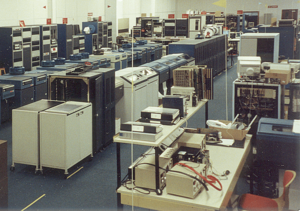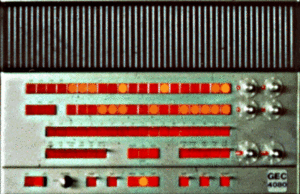GEC 4000 series facts for kids
The GEC 4000 was a group of powerful minicomputers made in the United Kingdom. These computers were built by GEC Computers Ltd from the 1970s to the early 1990s. They were special because they could handle both 16-bit and 32-bit information.
Contents
The Story of GEC 4000 Computers
GEC Computers started in 1968. They needed to create new computer systems. The first computer in this new series was the GEC 4080. It was designed by Dr. Michael Melliar-Smith. Later, Peter Mackley designed other models like the 4060 and 4090.
These computers were first made in Borehamwood, UK. Later, in the late 1970s, production moved to Dunstable. In 1979, GEC Computers won the Queen's Award for Technical Achievement. This award was for their work on the 4000 series, especially a special part called Nucleus.
By the 1990s, fewer systems were being made. The last GEC 4000 computers were built around 1995. Even so, some of these old computers were still working many years later! For example, London Underground was still using GEC 4190 systems in 2022.
Nucleus: The Computer's Brain
The GEC 4000 computers had a special feature called Nucleus. Think of Nucleus as a very smart helper built right into the computer's hardware. It handled many important tasks that usually an operating system would do.
Because Nucleus was built into the computer, it made the systems very secure. No other program could change how Nucleus worked. This made these computers very popular for jobs where security was super important.
Nucleus helped the computer by:
- Managing different tasks (called processes).
- Switching between tasks very quickly.
- Handling messages between different parts of the computer.
- Protecting different parts of the computer's memory.
- Dealing with errors and problems.
- Controlling how the computer talked to other devices (like printers).
Because Nucleus did so much, the operating systems on GEC 4000 computers didn't need to do these things themselves. This meant that even important parts of the operating system ran like regular programs. They were all kept safe from each other.
How the Computer Understood Instructions
The GEC 4000 series used a special set of commands called an instruction set. This is like the computer's own language. It told the computer what to do.
Older models used 16-bit instructions. Newer ones, from the 4090 onwards, could use both 16-bit and 32-bit instructions. This meant they could handle more information at once. The computer had special places to store information, like the A register for main calculations. It also had registers for things like pointing to data or keeping track of the next instruction.
Connecting to Other Devices
The GEC 4000 computers used special parts called Input/Output Processors (IOPs). These IOPs helped the computer talk to all its different devices. Once an IOP started a task, it worked on its own without bothering the main computer.
Most GEC 4000 systems had at least one IOP. The 4080 model had a "Basic Multiplexer Channel" (BMC) as its first IOP. Later models had more advanced IOPs.
Many different devices could connect to these computers, such as:
- Timers to keep track of time.
- Controllers for the system console (where you typed commands).
- Devices for reading and punching punched tape.
- Printers to print documents.
- Disk controllers for storing data.
- Magnetic tape controllers for backup.
- Controllers for connecting to other computers (serial communication).
- Digital I/O boards for controlling machines directly.
Newer IOPs were designed in the 1980s. These allowed for even smarter ways to connect devices. For example, a SCSI IOP was made to connect modern disks.
Who Used GEC 4000 Computers?
Many different groups and companies used GEC 4000 computers. They were very popular in the UK and beyond.
Some users included:
- Many universities in Britain, especially for science and engineering.
- Research centers like Rutherford-Appleton Laboratory and CERN.
- Big companies like ICI and British Telecom.
- Steel companies like British Steel Corporation, who used them to control steel mills.
- Train companies like British Rail and London Underground for scheduling trains.
- Fire brigades, like London Fire Brigade, for managing emergency calls.
- They also controlled most of the world's national Videotex systems, like the Prestel service.
At the Rutherford-Appleton Laboratory, a GEC 4000 system helped control a special machine called the ISIS neutron source until 1998. A GEC 4080M was even used in the radar system of the Nimrod AEW.3 aircraft.
Different Models of GEC 4000
Many different versions of the GEC 4000 computer were made over time. Here are some of them:
- 4080: The first model from 1973.
- 4082: An improved 4080 with more memory.
- 4070: A simpler, entry-level model.
- 4085: A 4082 that used newer, faster memory.
- 4060: A smaller, entry-level model.
- 4080M: A tough, compact 4080 made for military use.
- 4090: A more powerful model with 32-bit features and more memory.
- 4190: An updated 4090 with even more memory.
- 4180: A cheaper and slower version of the 4190.
- 4150: A desktop version of the 4160.
- 4190D: A very powerful 4190 with two processors.
- 4220: A redesigned 4190 using newer technology.
- 4310: A system that acted like a GEC 4220 but used different internal parts.
Software for GEC 4000
Several important programs and operating systems were available for the GEC 4000 series. These helped users run the computers and create their own programs.
Some of the operating systems included:
- COS: A "Core Operating System" for systems without disks.
- DOS: A "Disk Operating System" that allowed for file storage.
- OS4000: A system that allowed many users to work on the computer at once.
- SCP-2: A very secure operating system.
People could also write programs using different programming languages, such as:
- Babbage (a special language for this computer).
- FORTRAN IV
- CORAL 66
- ALGOL
- APL
- BASIC
See also
- GEC Series 63
- GEC 2050 8-bit minicomputer



